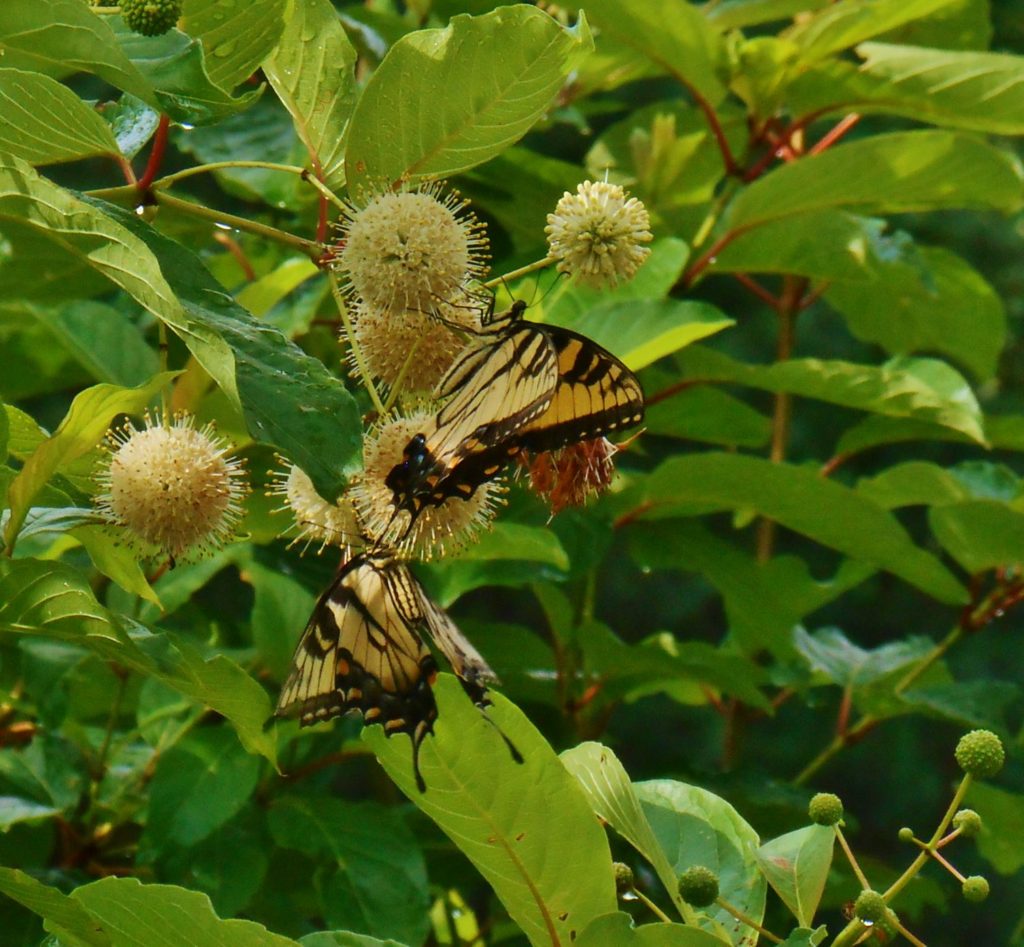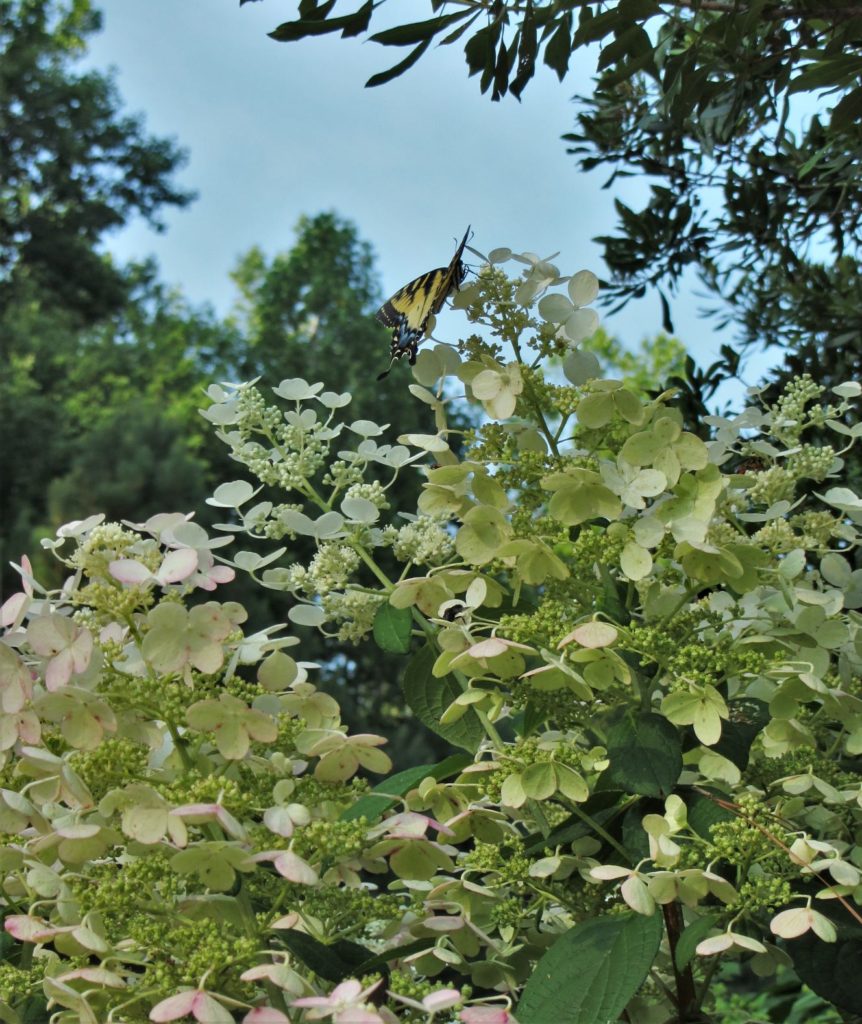Summer Flowering Trees and Shrubs for Pollinators
Have you ever watched a bumblebee explore a Hibiscus flower? Each flower is large enough for the bee to crawl around the depths of its funnel shaped petals to collect as much pollen as possible. Short, powdery stamens grow like bristles on a bottle brush from a long, tubular pistil. The bee emerges white with pollen and satisfied by the flower’s nectar.
Hibiscus shrubs, commonly known as Rose of Sharon, bloom from June through November in our area. Each tree holds dozens of flowers throughout a long season, and each pollinated flower produces a capsule filled with seeds that sustain birds through the winter and into early spring. I still see birds searching for these nourishing seeds after the tree has leafed out the following year.
Hibiscus syriacus, the tree Hibiscus, is native to Asia. Another of its many names is ‘Rose of China.’ You may also know it as ‘Shrub Althea.’ At maturity, it may grow to 12’ tall and 10’ wide, but most remain smaller. It may grow as a standard on a single trunk, or in shrub form with several trunks. Hibiscus moscheutos and Hibiscus coccineus, both native to our area, have similar flowers that grow on tall, herbaceous stems which die back to the ground in fall.
When we first moved into our new home, we considered cutting away some of the many rose of Sharon trees growing all around the place because they looked a bit spindly and awkward. And then one day I noticed a hummingbird feeding from one that grew beyond our living room window. We were mesmerized as the hummingbirds returned again and again to feed from those large, lavender flowers.
We noticed butterflies visiting the flowers, too. And so many bees! How could we cut down a flowering tree that supports so many different creatures?
Hibiscus syriacus is only one example of a non-native summer flowering trees that support wildlife through much of the year. It is functional in our garden, and with proper pruning, it can be very attractive when covered in flowers.
Hardy to Zone 5, Rose of Sharon should be pruned in early spring. It blooms on new wood, and pruning stimulates that new growth that will break into bloom by early summer. Grow it in full sun to partial shade in fertile soil. This shrub hybridizes easily and produces thousands of viable seeds. Once you have it, you’ll soon find lots of seedlings to pot and share.
The Benefits of Planting Summer Flowering Trees and Shrubs
In many ways, flowering trees and shrubs are superior to herbaceous annuals and perennials for supporting pollinators. One reason is the sheer volume of flowers each will produce over the season. They require less irrigation because their roots run deep into the soil. You may not need to dead head spent blooms to keep the flowers coming over a long season. Once planted, they largely care for themselves, beyond a bit of annual pruning.
In a small yard, a flowering tree or shrub may be the best solution to attract the largest number of pollinators throughout the summer. Many can grow in a large container on a patio or deck and can take heavy pruning to control size. All bloom on new wood that grows that season. As an added benefit, birds will visit to feed, nest and take shelter in their branches. They provide color and drama over several months with a minimal investment of effort.

Native Buttonbush, Cephalanthus occidentalis, blooms in early summer. It has been cultivated as a nectar source for honeybees since 1735.
Natives vs. Imports
You may notice that very few native trees and shrubs bloom after early summer. Exceptions are the Magnolia grandiflora which opens its huge white flowers by late May, and then sporadically through the summer; and Hydrangea quercifolia, the oakleaf Hydrangea, that blooms in May and holds its flowers into the winter. Other native Hydrangeas, including Hydrangea serrata, Hydrangea arborescens and Hydrangea cinerea, also bloom throughout summer in our area, supporting many pollinators.
Most flowering trees and shrubs on the market are imported species that have been heavily hybridized. Superior varieties are marketed for size, habit, flower color, and disease resistance. Hybrids may have the added advantage of sterility.

Hydrangea paniculata ‘Quick Fire’ blooms in the flowering shrub border at the Williamsburg Botanical Garden
Hybrid Hydrangeas
Hydrangea paniculata and Hydrangea macrophylla, both imported from Asia, are even more popular than our native Hydrangeas. There are more choices of flower color and form and overall plant size. They are so popular in the United States and have been grown for so long that many people might assume them to be native plants.
Hydrangeas are very easy to grow in a wide variety of situations but will be grazed by deer. Hydrangea macrophylla blooms in the shade and requires consistently moist soil to grow in partial or full sun. These shrubs attract pollinators but don’t produce unwanted seeds. Deadhead spent flowers to encourage more flowers to bloom through the season.
Chinese Abelia
Chinese Abelia, Linnaea chinensis, grew around all my childhood homes. I could entertain myself for hours catching bumble bees in glass jars as they fed on nectar, and then turning them loose again. There were always bees on the Abelia. Hardy in Zones 6-9, it is semi-evergreen in our area and very easy to grow in a wide variety of situations from full sun to partial shade.
It grows in neatly rounded mounds to 7’ tall at maturity and responds well to shearing once a year or so to control its size. Its small, glossy leaves and tiny white or pink flowers appeal to many homeowners.
Butterfly Bush
Butterfly bush, Buddleia davidii, native to China, attracts butterflies, hummingbirds, native bees, wasps, and other insect pollinators. Its long panicles of flowers are fragrant and come in a rainbow of saturated color. Some even have variegated leaves. Deer leave them alone.
The species can grow to 12’ tall and 10’ wide. As the flowers fade, panicles should be trimmed away to encourage more bloom and prevent seed formation. Butterfly bush has been criticized for its promiscuous ways. They seed themselves all over the place, unless you have planted a sterile hybrid variety. The species is considered invasive in some parts of the country.
A new line of sterile Buddleia hybrids, including Buddleia ‘Butterfly Grande,’ remain small enough to grow in large containers and won’t self-seed. They bloom from June through November and call to every butterfly in the area.
Chaste Tree
A small tree covered by panicles of lavender, pink, purple or white flowers, sometimes mistaken for Buddleia, is Vitex agnus-castus, the chaste tree. Native to the Mediterranean region, it is native to Zone 5 or 6 with mulch, but prefers warmer climates in Zones 7 to 9. Vitex can grow to 10’ tall and 8’ wide. It may die back to the ground in colder climates and return from the roots each spring. It can be pruned heavily in late winter to control its size. Pruning encourages more flowers and helps keep the tree neater and more attractive. Prune to a single branched trunk to grow as a tree, or allow multiple trunks to grow as a shrub.

Chaste tree, Vitex agnus-castus, may be confused with butterfly bush because their panicles of flowers look so similar
Chaste tree, a member of the Lamiaceae or mint family, contains essential oils and has many uses in folk medicine. It is used as an insect repellent and is impervious to grazing deer. It is valued as a good source of nectar for pollinators, particularly for honeybees, and feeds birds with its abundant seeds.
Crape Myrtle
Crape myrtle, Lagerstroemia indica, is the most popular summer flowering tree in our area, providing around 100 days of colorful flowers each year. These elegant trees with attractive peeling bark, to 40’ for some varieties, begin blooming in mid-June and continue until autumn.

Crape myrtle, Lagerstroemia indica, blooms for 100 or more days each summer from June through September
Huge panicles of white, pink, lavender, purple, or red flowers attract many different pollinators, including butterflies. Some of the newer selections have red or purple leaves, and all varieties turn orange or red in the fall. Newer selections are sterile, but some of the older varieties have naturalized in the Southeastern United States in Zones 7-9.
These trees are so easy to grow and pest resistant that they are widely planted as street trees in urban areas and around businesses and shopping centers. Light pruning is needed in late winter to open the form of the tree and remove seed heads from the previous season. Drastic pruning, known as ‘Crape Murder’ or pollarding, should be avoided as it spoils the form of the tree.

Crape myrtle should be allowed to grow into a graceful shape. Annual pruning should focus on removing suckers and thinning the canopy. Grow this tree as a standard or with multiple trunks.
Culture
Shop for healthy shrubs with a pleasing branch structure. Dig a hole twice the diameter of the pot, but no deeper. Plant your new shrub at the same depth as it is growing in its pot, because planting it deeper can kill it. Water it well before adding 2″-3″ of bark mulch over the root ball and extending a little beyond it, but don’t let the bark touch the trunk(s) of your new shrub. Water your new shrub regularly for the first year to prevent it from drying out. It will need more irrigation in hot weather, possibly every day during a dry spell. Deadhead spent flowers the first year at least, and remove any damaged or crossed branches at planting.
When planting in a container, choose a pot twice the diameter of the root ball, at least. Add some fine bark mulch to commercial potting soil. Plant the shrub so the top of the root ball is even with the top of the soil line and then mulch with shredded bark, careful that the mulch doesn’t touch the trunk(s). Water well, and water the container regularly so the soil never dries out completely. Never allow the container to stand in water as saturated soil will begin to kill the roots.
Fall is the best time for planting trees and shrubs in our area. However, the best time to find a good selection of flowering woodies is during the early summer as they begin to bloom. Many gardeners want to purchase the plant in bloom when they can examine the flowers. It can be tricky to keep a new shrub alive during that first summer, particularly during dry spells. Consider drip irrigation, and provide some shade during the hottest part of the season while the new roots begin to take hold. Consider re-potting the new shrub into a larger pot the first summer, and planting it into its permanent spot in your yard after mid-October, when the weather begins to cool.
New varieties of popular flowering woody plants come on the market each year, boasting improvements in disease resistance, form, color and size. The well-known varieties of Hydrangea, crape myrtle, Hibiscus, Abelia and Chaste tree remain popular because they’ve proven themselves reliable and easy to grow over time. It is hard to go wrong with any of these beautiful choices to support a variety of pollinators through the entire summer.
All photos by Elizabeth McCoy, with appreciation to the Williamsburg Botanical Garden and Freedom Park Arboretum, where several of these photos were taken. Learn more about the woody species growing in the WBG & FPA here and more about the Level 1 Arboretum here.
Elizabeth McCoy is a JCCW Master Gardener Tree Steward and a former Williamsburg Botanical Garden volunteer.














